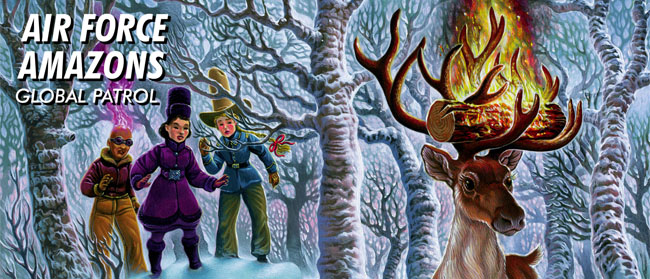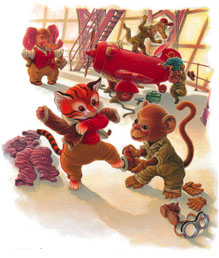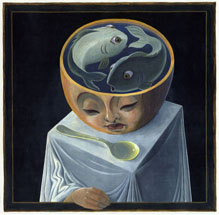Tuesday 13 May 2008
While the sun shines
Yesterday was a day off, after three or more seven-day weeks of work in a row. A late breakfast was followed by a visit to the Political Cartoon Gallery in Bloomsbury to see an exhibition of David Low drawings.
After so long indoors at my painting table, the sun's warmth, the crowds milling about, all felt overwhelming. For days my view of the outside world had been through news reports from over the horizon, of war, and war, and arguments about war. Here in central London the people in the streets felt happy and busy, energising and reassuring, but still in my mind brutal events beyond the visible insisted on their equal reality, and here too the potential for brutality was asserted in newspaper front pages about the knife murder in Oxford Street the previous afternoon.
On to the gallery and David Low, best known now as the creator of Colonel Blimp. The combination of precision and energy in his drawing, particularly in the work from the '30s, is startling. Even his earliest work betrays no doubt or insecurity.
While I was there I picked up a secondhand copy of Avisens Håndskrift (The Newspaper's Handwriting) by Hans Edvard Nørregård-Nielsen, a look at the work of members of Danske Bladtegnere, the Danish newspaper illustrators' society, on the occasion of the society's fiftieth anniversary in 1983. As I'd just been looking at Low, I was curious to see what the book would include from the occupation period. Not much was the answer. There were a couple of anti-Nazi cartoons from before the war, and a couple more from afterwards. The only images from the period of occupation were a couple of pleasant drawings, one of women on a beach, another of birds singing.
Absence makes the mind more curious. What did political cartoonists do during the occupation? Did they all turn to pretty pictures? Did any professional cartoonists also work for resistance papers?
So off I went to search—
Here's one anti-Nazi cartoon by Viggo Rohde from an underground book published in 1943 marking the second anniversary of war between Nazi Germany and the USSR. It's part of an online exhibit of underground wartime publications on the Danish Royal Library website.
1943 i tekst og tegninger, (1943 in words and pictures,) was a book from the Communist Land og Folk< underground press with cartoons by Herluf Bidstrup and Thorkild Holst. Images here and here and here and here. At least one of those same cartoonists seems to be responsible for the cartoons here and here in another Danish Communist Party publication, Ugens Nyt, (The Week's News,) again from 1943. Here and here are postcards by Herluf Bidstrup. According to Avisens Håndskrift, Bidstrup stayed with the Land og Folk paper after the war, and his work remained very much in line with party policy.
This cartoon, Leaders of the New Order is by Anton Hansen, who assumed a change in drawing style to hide his identity. His work had appeared before the war in Arbeiderbladet in Norway, Simplicissimus and Das Panoptikon in Germany, as well as Ekstrabladet in Denmark. After the war he worked for Information, a daily that had begun life as an underground news agency. This drawing however was published in Danske Tidene, an underground newspaper begun under the editorship of Nicolai Blædel, who as foreign editor of Berlingske Tidene prior to the invasion had been strongly critical of the Nazis, and was one of the first writers to be banned from publishing under the occupation.
Here's a poster published by Morgenbladet, an underground daily newspaper launched in November 1944 by the Dansk Samlings party, and here's a report on the poster in the paper - I was surprised by the scale of it! From the same press came a humour magazine Muldvarpen, (The Mole,) with a mix of Danish cartoons and material supplied by the allies, including this Donald Duck strip.
Altogether the volume of material published by various parts of the Danish resistance seems to have been enormous. Morgenbladet for example published 142 issues under occupation, with a circulation reaching 7,000 in the last months of the war. As you can see in the Danish Royal Library exhibition, most underground material was typewritten or very simply typeset, but a surprising amount was also illustrated to a high standard.
Illustrations:
The top four drawings are by David Low, all from The Complete Colonel Blimp, edited by Mark Bryant, and are copyright © Low estate/Solo Syndication.
Blimp in the '30s was portrayed as a conservative appeaser of fascism. The character in the fourth drawing, Pmilb, the inverse of Blimp, was his leftist mirror image, an equally wrongheaded appeaser.
I've written a little on the Colonel Blimp film here, and more on Denmark under occupation here.
The bottom three drawings are by Hans Bendix, all from Avisens Håndskrift, Dansk bladtegning gennem et halvt århundrede, by Hans Edvard Nørregård-Nielsen, copyright © Dansk Bladtegnere.
Bendix's Hitler caricature, titled Dollfuss in Memoriam, was published in Tegning af tiden in 1935. The Port Jefferson beach drawing was for the cover of Hjemmets Søndag, a colour supplement to the paper Social-Demokraten, published in 1941.
Labels:
blimp,
books,
comics and cartoons,
denmark,
london,
norway,
out of my room,
politics,
powell and pressburger,
ww2
Subscribe to:
Post Comments (Atom)


















5 comments:
Thank you. The Col Blimp cartoons are fascinating.
Funny that two terrific artists drew from different sides of the barricade having started together. Blix and Gulbranson. And both were VERY good!
I don't know much about Blix and Gulbransson, I'm afraid, other than the wonderful pictures on your blog, and over at that other fellow's place.
Ah, that didn't take long, I see Gulbransson was the Norwegian artist accused of collaboration, and Blix the Norwegian who did anti-Nazi cartoons under a pseudonym (Stig Höök) for publication in Sweden.
And to tie in with my other post on wartime Denmark, here's a Stig Höök drawing with the title Informers must be Executed, where Death remarks "If I have to be party to this as well then I need a blindfold."
Blimp might well be G K Chesterton
Post a Comment